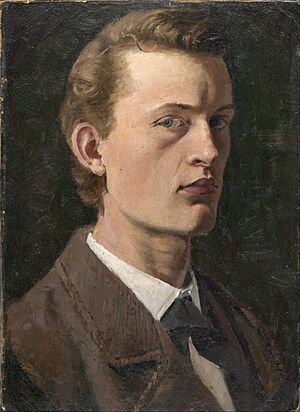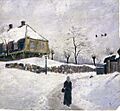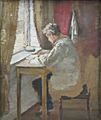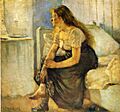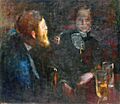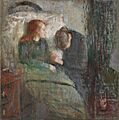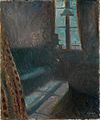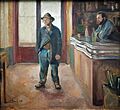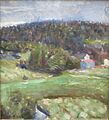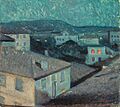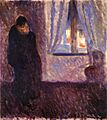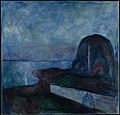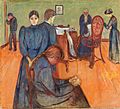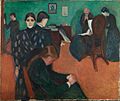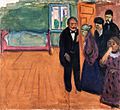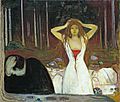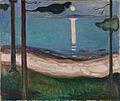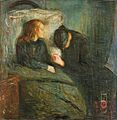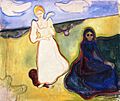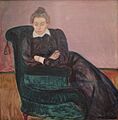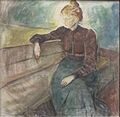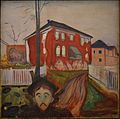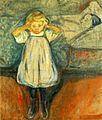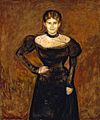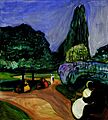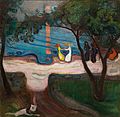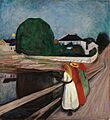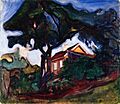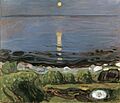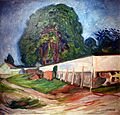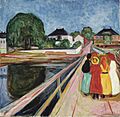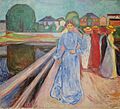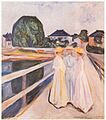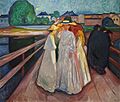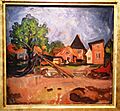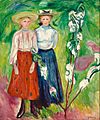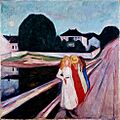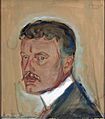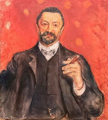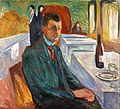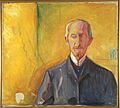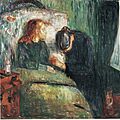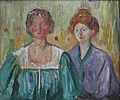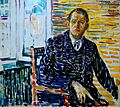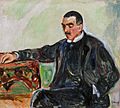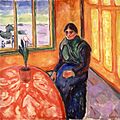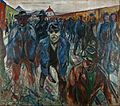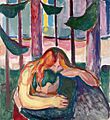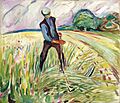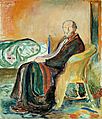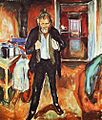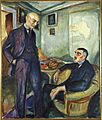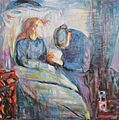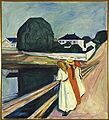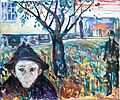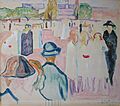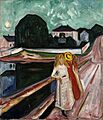List of paintings by Edvard Munch facts for kids
This page lists many paintings by Edvard Munch, a famous Norwegian artist. He was a Symbolist painter and printmaker. Munch is most known for his painting The Scream. This list comes from a detailed book about his artworks by Gerd Woll, published in 2008.
Contents
Who Was Edvard Munch?
Edvard Munch was born in Norway in 1863. He became one of the most important artists of his time. His paintings often showed strong feelings like sadness, fear, and love. He used bright colors and unique brushstrokes to express these emotions.
Early Paintings (1880s)
Munch started painting when he was very young. His early works often showed scenes from his home and the nature around him.
- Family Life: He painted his family members, like his father Christian Munch and his aunt Karen Bjølstad. He also painted their living room.
- Landscapes: Many early paintings show places in Norway, like Telthusbakken with Gamle Aker Church and Autumn in the Forest. He loved painting the changing seasons.
- Self-Portraits: Munch often painted himself. His Self-Portrait from 1882 shows him as a young artist.
Key Paintings from the 1880s
- The Sick Child (1885-86): This painting shows a young girl who is very ill. It is a very emotional work, inspired by Munch's own sister who died young.
- Puberty (1886): This painting shows a young girl sitting on a bed. It explores the feelings of growing up and becoming an adult.
- Tête-à-tête (1885): This painting shows two people talking closely. It captures a quiet moment between them.
Famous Works (1890s)
The 1890s were a very important time for Munch. He created some of his most famous and powerful paintings during these years. Many of these works explore themes of life, love, fear, and death.
- The Frieze of Life: Munch planned a series of paintings called "The Frieze of Life." These paintings explored human emotions and experiences.
- Nature and Feelings: He often painted scenes from Åsgårdstrand, a small town by the sea. These landscapes often reflected his inner feelings.
Iconic Paintings from the 1890s
- Night in Saint-Cloud (1890): This painting shows a dark room with a figure looking out a window at a city. It captures a feeling of loneliness.
- Melancholy (1891): This painting shows a person sitting by the water, looking sad. It shows deep feelings of sorrow.
- Rue Lafayette (1891): This painting shows a busy street in Paris. It captures the energy of city life.
- The Kiss (1892): This painting shows two people embracing. Their faces are blended together, showing how close they are.
- The Scream (1893): This is Munch's most famous painting. It shows a figure holding their head and screaming, with a swirling sky behind them. It expresses intense fear and anxiety. There are several versions of this painting.
- Vampire (1893): This painting shows a woman with red hair kissing a man's neck. It is sometimes called "Love and Pain" and explores strong, complex emotions.
- Ashes (1895): This painting shows a man and a woman in a forest. It suggests feelings of loss and the end of a relationship.
- Jealousy (1895): This painting shows a man looking intensely at a couple. It captures the strong emotion of jealousy.
- Self-Portrait with Cigarette (1895): This self-portrait shows Munch looking directly at the viewer, surrounded by smoke. It has a mysterious and thoughtful mood.
- Dance of Life (1899-1900): This large painting shows people dancing in a landscape. It represents different stages of life, from youth to old age.
Later Works (1900s-1940s)
In his later years, Munch continued to paint many different subjects. He explored new styles and colors, often focusing on nature and everyday life.
- Landscapes: He painted many scenes from his home in Ekely, Norway. These include The Apple Tree and Winter in the Woods.
- Portraits: Munch painted many portraits of friends and important people, like Walter Rathenau and Friedrich Nietzsche.
- Workers: He also painted scenes of working people, such as Mason and Mechanic and Workers on their Way Home. These show the strength and dignity of labor.
- Self-Portraits: He continued to paint himself, showing his changing appearance and feelings over time. Examples include Self-Portrait With a Bottle of Wine and Self-Portrait with the Spanish Flu.
- University Murals: Munch created large paintings for the University of Oslo's main hall, called the Aula. These include The Sun and History, which are about knowledge and human life.
Notable Later Paintings
- The Girls on the Bridge (1901): This painting shows young girls standing on a bridge, looking out at the water. It is a peaceful and thoughtful scene.
- Self-Portrait in Hell (1903): This powerful self-portrait shows Munch surrounded by fiery colors, expressing inner struggle.
- The Sun (1910-11): A bright and hopeful painting, showing the sun's rays over a landscape. It was part of his work for the University of Oslo.
- Galloping Horse (1910-12): This painting captures the movement and power of a horse.
- The Yellow Log (1912): A vibrant painting of a log in a forest, showing Munch's interest in nature's colors.
- The Haymaker (1917): This painting shows a person working in a field, highlighting rural life.
- Self-Portrait. Between the Clock and the Bed (1940-43): One of his last self-portraits, showing him standing between a clock and his bed, reflecting on time and life.
Images for kids


